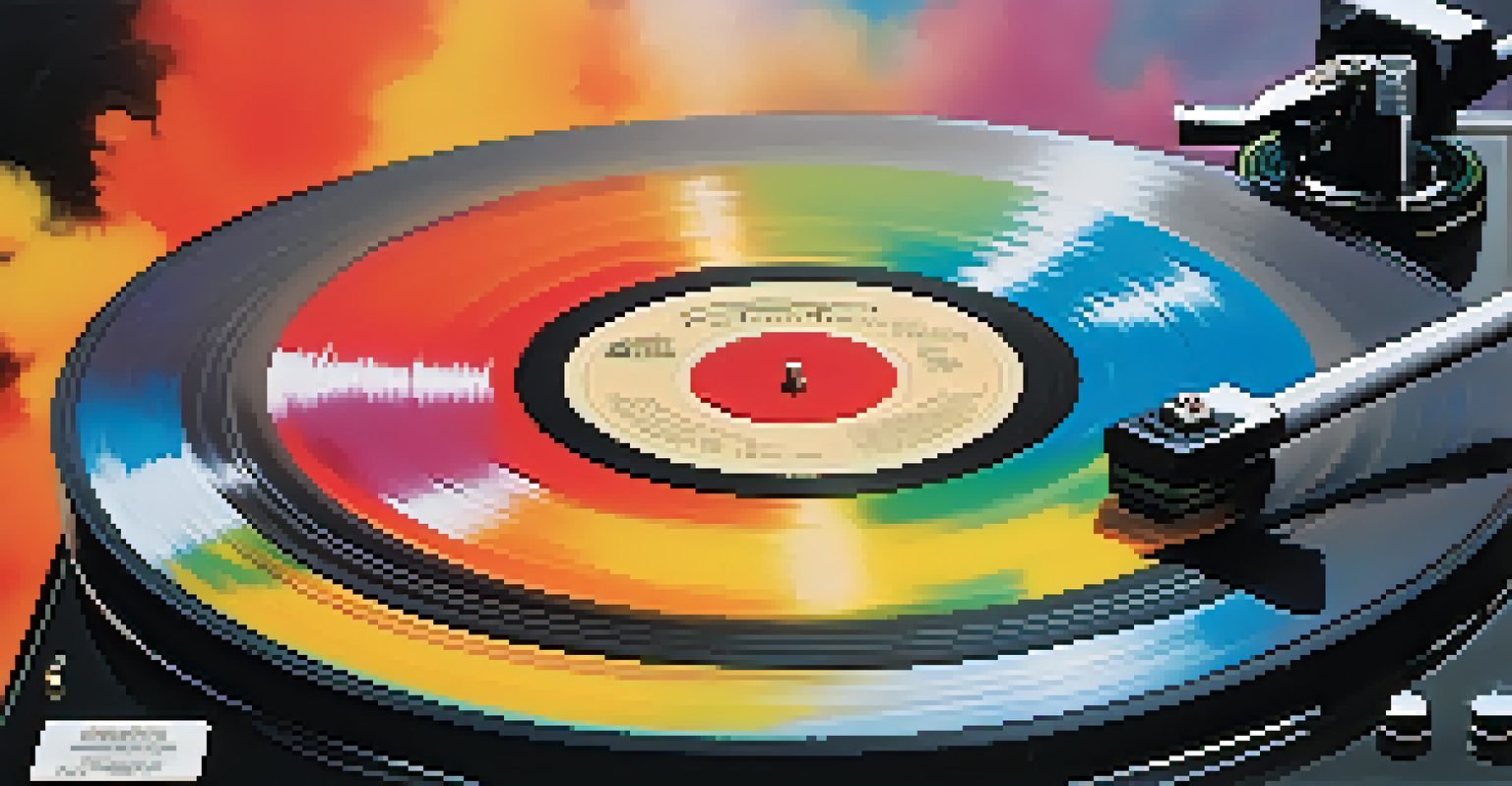Marijuana's Impact on the Psychedelic Rock Movement

The Cultural Context of the 1960s Music Scene
The 1960s was a transformative time for music, infused with social change and experimentation. Rock and roll was evolving, and with it came new sounds that challenged the status quo. This era was marked by a counterculture that embraced freedom, peace, and, notably, alternative lifestyles—including the use of marijuana. Musicians began to explore themes of consciousness, love, and rebellion, setting the stage for the psychedelic rock movement.
Music is a safe kind of high.
As artists sought to break away from conventional music styles, they turned to marijuana as a tool for creativity and inspiration. This herb became a symbol of a generation that rejected mainstream values, encouraging musicians to delve deeper into their artistic expression. Bands like The Beatles and The Grateful Dead began to experiment with their sound, often attributing their innovative approaches to their use of cannabis.
The impact of marijuana was not limited to the sound alone; it influenced the whole culture surrounding music festivals, communal living, and artistic collaborations. The use of marijuana fostered a sense of unity among musicians and fans, helping to create an environment ripe for experimentation. This cultural backdrop laid the foundation for what would become the vibrant psychedelic rock movement.
Marijuana and the Sound of Psychedelic Rock
Psychedelic rock is characterized by its experimental sounds, unusual time signatures, and incorporation of non-traditional instruments. Marijuana played a crucial role in shaping these musical elements, as artists sought to transport listeners to new auditory landscapes. The use of reverb, echo, and other effects often mirrored the altered states of consciousness that marijuana could induce.

For instance, bands like Pink Floyd and Jefferson Airplane created soundscapes that were not just songs but experiences. Their music often featured extended instrumental sections and surreal lyrics, reflecting the mind-expanding effects of marijuana. This approach resonated deeply with audiences looking for a deeper connection to music and art.
Marijuana Shaped Psychedelic Sound
The use of marijuana significantly influenced the experimental sounds and themes found in psychedelic rock music.
Moreover, marijuana encouraged spontaneity in live performances, leading to the improvisational style that became a hallmark of psychedelic rock concerts. Musicians were often in a state of flow, allowing creativity to guide their performances and resulting in unique, unforgettable experiences for fans. This synergy between marijuana and music redefined the concert experience and solidified the genre's legacy.
Lyricism and Themes Influenced by Cannabis
The lyrics of many psychedelic rock songs reflect the altered perceptions and introspective journeys inspired by marijuana. Themes of love, existentialism, and cosmic exploration became prevalent, as artists sought to articulate their experiences. For example, The Doors often wrote about the quest for freedom and transcending reality, which resonated with the countercultural ethos of the time.
The only thing better than singing is more singing.
Marijuana also opened the door to more abstract lyricism, allowing songwriters to explore topics in unconventional ways. Bands like The Byrds and Cream incorporated surreal imagery and metaphor, encouraging listeners to interpret their music through a psychedelic lens. This shift in songwriting made the genre more accessible to fans who were also exploring their consciousness.
As artists pushed boundaries with their lyrics, they challenged societal norms and sparked conversations about mental health, spirituality, and social justice. The influence of marijuana on psychedelic rock lyrics thus became a vehicle for both personal expression and broader cultural critique, solidifying its role in the movement.
Iconic Albums Born from Cannabis Inspiration
Several landmark albums from the psychedelic rock era were heavily influenced by marijuana. The Beatles' 'Sgt. Pepper's Lonely Hearts Club Band' is often cited as a prime example, with its experimental sounds and surreal lyrics reflecting the band's exploration of consciousness. The album was a defining moment in music history, showcasing how marijuana can inspire creativity and innovation.
Another notable album is Pink Floyd's 'The Piper at the Gates of Dawn', which was largely influenced by the band's use of cannabis during songwriting sessions. The combination of Syd Barrett's whimsical lyrics and the band's experimental sound created a dreamlike listening experience that captured the essence of psychedelic rock. These albums not only defined the genre but also pushed the limits of what music could achieve.
Iconic Albums Reflect Cannabis Culture
Landmark albums like 'Sgt. Pepper's' and 'The Piper at the Gates of Dawn' showcase how marijuana inspired creativity and innovation in music.
Additionally, The Doors’ self-titled debut album featured tracks that combined haunting melodies with deep lyrical content, further reflecting the complex relationship between marijuana and music creation. These iconic works remain timeless, illustrating how marijuana played a pivotal role in shaping the soundscape of the psychedelic rock movement.
The Role of Marijuana in Live Performances
Live performances during the psychedelic rock era were often immersive experiences that transcended mere music. Marijuana played a significant role in this, as artists and audiences alike embraced the herb to enhance their senses. Concerts became communal celebrations where participants could freely express themselves, creating an electrifying atmosphere that was both cathartic and euphoric.
The improvisational nature of many psychedelic rock bands meant that no two performances were ever the same. The influence of marijuana allowed musicians to take creative risks on stage, resulting in spontaneous jams and extended solos. This unpredictability made concerts thrilling and left lasting impressions on those who attended, fostering a sense of connection among fans.
Venues like the Fillmore and the Avalon Ballroom became iconic spaces where the marriage of marijuana, music, and community flourished. These concerts were not just about the music; they were about shared experiences and collective consciousness, highlighting the pivotal role that marijuana played in the evolution of live psychedelic rock performances.
Marijuana's Cultural Legacy in Psychedelic Rock
The legacy of marijuana within the psychedelic rock movement extends beyond its musical contributions. It helped to cultivate a culture of acceptance, creativity, and exploration that has influenced countless artists and genres since. The spirit of the 1960s continues to inspire new generations, with artists across various musical landscapes drawing from the ethos of psychedelic rock and its connection to cannabis.
Moreover, the ongoing conversation about marijuana legalization has roots in the cultural shifts initiated by the psychedelic movement. As society reassesses its views on cannabis, the music of this era reminds us of the herb's role in fostering creativity and community. This cultural shift has led to a renewed interest in the music and art of the 1960s, further solidifying marijuana's legacy.
Live Shows Fostered Community Vibes
Marijuana played a crucial role in creating immersive live performances that emphasized spontaneity and connection among audiences.
Today, festivals celebrating psychedelic music often embrace cannabis culture, promoting a sense of freedom and artistic expression. This enduring relationship speaks to the profound impact marijuana has had on music and culture, ensuring that its influence will remain a vital part of the artistic landscape for years to come.
Conclusion: The Lasting Impact of Marijuana on Music
The relationship between marijuana and the psychedelic rock movement is a testament to the power of creativity and cultural change. As artists explored new sounds and themes, they also reshaped the societal landscape, encouraging open-mindedness and self-expression. This synergy created a rich tapestry of music that continues to resonate with listeners today.
Through the lens of cannabis, musicians were able to push boundaries and challenge conventions, leading to a genre that was as much about the experience as it was about the sound. The psychedelic rock movement not only influenced music but also left a lasting mark on art, fashion, and social attitudes, showcasing how intertwined these elements can be.

As we reflect on the impact of marijuana on psychedelic rock, we celebrate a unique fusion of culture, creativity, and consciousness. This movement serves as a reminder of the potential for music to transcend the ordinary, inviting us to explore the depths of our imagination and the world around us.